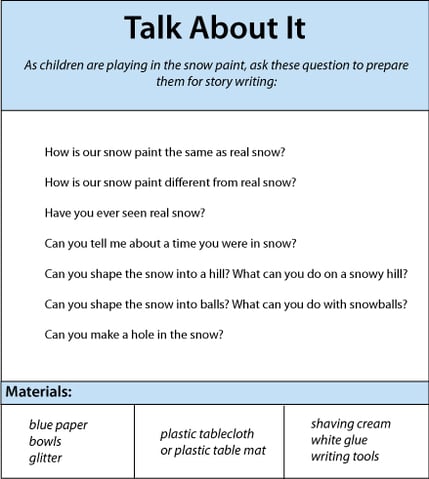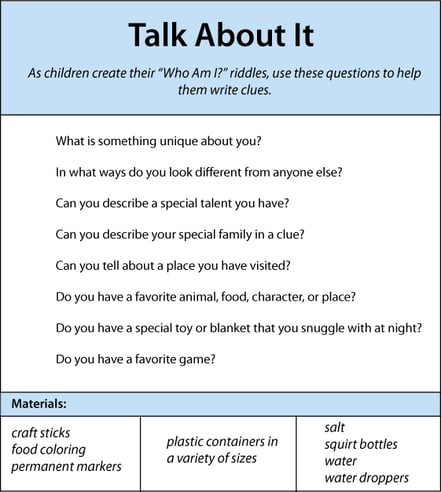Here at Gryphon House, we are proud to work with so many talented early education authors. This week we're featuring Playful Writing by Rebecca Olien and Laura Woodside. The book includes 150 activities that explore and support literacy learning. We thought it was appropriate to showcase winter activities for you to share with your kiddos! Read more about the book here.
My Snowy Day
Make sparkly snow paint to use first for play and then for decorating snowy-day stories!
Play Time!
- Make snow paint by mixing together equal parts of white glue and shaving cream. Stir in glitter.
- Spread generous amounts of the sparkly snow paint onto your plastic tablecloth or place mats, and give the children time to play in the "snow."
Write/Draw: Snowy Day Stories
- Early Writers--can paint a snow scene; it will dry puffy and velvety! Encourage them to write snow stories using words, drawings, and invented spelling to describe their snow scenes.
- Ready Writers--can create scenes and then write their snowy-day stories. They may wish to write a narrative based on a real-life experience or an imaginary snow story. Encourage them to include a beginning, middle, and end, as well as detail words. Use these questions, if needed, to help them get started:
- Beginning: What did the snow look like? How did you get ready to go out in the snow?
- Middle: What happened when you went out into the snow? How did it feel? Were there other people or animals in the snow with you? Was there a problem in the snow? How did you solve the problem?
- End: How did your time in the snow end?

Ice-Sculpture Riddles
Use explorations in ice to inspire the children's writing.
Play Time
- Before the activity, create your own frozen ice riddle, so the children can see how the activity works.
- Place half-filled containers of water into a freezer, and let the water begin to freeze while the children do the Write/Draw activity.
- Give the children craft sticks and permanent markers, and assist them as needed to complete the Write/Draw activity and create "Who Am I?" riddle sticks.
- Once the water is partially frozen, insert the completed riddle sticks in the water, add a few drops of food coloring, and fill the containers the rest of the way with water. Return the containers to the freezer.
- When the water is completely frozen, remove the ice from the containers and bring it outside for the children to examine.
- Provide salt, squirt bottles, water droppers, and cups to the children. Encourage them to melt the ice to discover the riddles inside.
- Help them read the riddle sticks. Invited them to guess which classmate is the answer to each riddle
Write/Draw: Riddle Sticks
1. Early Writers--can create riddle sticks from jumbo-sized craft sticks (to give them more room to write). Encourage them to write one great clue about themselves that is only true about them. Consider giving them sentence starters, such as,
- I can_______.
- I am _______.
- I have _______.
- My favorite _____ is _______.
2. Ready Writers--can write at least one clue on each side of their sticks. Remind them that they are trying to think of clues about themselves that are unique!

Tell us what you thought about the writing activities!
Author(s)Laura Woodside, Rebecca Olien
Jenna Roby
A graduate of High Point University, Jenna Roby served as marketing specialist for Gryphon House from 2013-2015.

